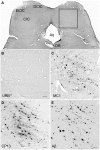Localization of mutant ubiquitin in the brain of a transgenic mouse line with proteasomal inhibition and its validation at specific sites in Alzheimer's disease
- PMID: 25852488
- PMCID: PMC4362318
- DOI: 10.3389/fnana.2015.00026
Localization of mutant ubiquitin in the brain of a transgenic mouse line with proteasomal inhibition and its validation at specific sites in Alzheimer's disease
Abstract
Loss of protein quality control by the ubiquitin-proteasome system (UPS) during aging is one of the processes putatively contributing to cellular stress and Alzheimer's disease (AD) pathogenesis. Recently, pooled Genome Wide Association Studies (GWAS), pathway analysis and proteomics identified protein ubiquitination as one of the key modulators of AD. Mutations in ubiquitin B mRNA that result in UBB(+1) dose-dependently cause an impaired UPS, subsequent accumulation of UBB(+1) and most probably depositions of other aberrant proteins present in plaques and neurofibrillary tangles. We used specific immunohistochemical probes for a comprehensive topographic mapping of the UBB(+1) distribution in the brains of transgenic mouse line 3413 overexpressing UBB(+1). We also mapped the expression of UBB(+1) in brain areas of AD patients selected based upon the distribution of UBB(+1) in line 3413. Therefore, we focused on the olfactory bulb, basal ganglia, nucleus basalis of Meynert, inferior colliculus and raphe nuclei. UBB(+1) distribution was compared with established probes for pre-tangles and tangles and Aβ plaques. UBB(+1) distribution found in line 3413 is partly mirrored in the AD brain. Specifically, nuclei with substantial accumulations of tangle-bearing neurons, such as the nucleus basalis of Meynert and raphe nuclei also present high densities of UBB(+1) positive tangles. Line 3413 is useful for studying the contribution of proteasomal dysfunction in AD. The findings are consistent with evidence that areas outside the forebrain are also affected in AD. Line 3413 may also be predictive for other conformational diseases, including related tauopathies and polyglutamine diseases, in which UBB(+1) accumulates in their cellular hallmarks.
Keywords: RNA; basal ganglia; frameshift mutation; inferior colliculus; nucleus basalis of Meynert; olfactory bulb; raphe nuclei; ubiquitin B+1.
Figures








Similar articles
-
Misframed ubiquitin and impaired protein quality control: an early event in Alzheimer's disease.Front Mol Neurosci. 2015 Sep 2;8:47. doi: 10.3389/fnmol.2015.00047. eCollection 2015. Front Mol Neurosci. 2015. PMID: 26388726 Free PMC article. Review.
-
Long-term proteasomal inhibition in transgenic mice by UBB(+1) expression results in dysfunction of central respiration control reminiscent of brainstem neuropathology in Alzheimer patients.Acta Neuropathol. 2012 Aug;124(2):187-97. doi: 10.1007/s00401-012-1003-7. Epub 2012 Jun 23. Acta Neuropathol. 2012. PMID: 22730000 Free PMC article.
-
Frameshift proteins in Alzheimer's disease and in other conformational disorders: time for the ubiquitin-proteasome system.J Alzheimers Dis. 2006;9(3 Suppl):319-25. doi: 10.3233/jad-2006-9s336. J Alzheimers Dis. 2006. PMID: 16914870 Review.
-
Mutant ubiquitin decreases amyloid β plaque formation in a transgenic mouse model of Alzheimer's disease.Neurochem Int. 2012 Oct;61(5):739-48. doi: 10.1016/j.neuint.2012.07.007. Epub 2012 Jul 14. Neurochem Int. 2012. PMID: 22797007
-
Low levels of mutant ubiquitin are degraded by the proteasome in vivo.J Neurosci Res. 2010 Aug 15;88(11):2325-37. doi: 10.1002/jnr.22396. J Neurosci Res. 2010. PMID: 20336771
Cited by
-
Machine Learning Classification Identifies Cerebellar Contributions to Early and Moderate Cognitive Decline in Alzheimer's Disease.Front Aging Neurosci. 2020 Nov 3;12:524024. doi: 10.3389/fnagi.2020.524024. eCollection 2020. Front Aging Neurosci. 2020. PMID: 33240072 Free PMC article.
-
Pathology-specific patterns of cerebellar atrophy in neurodegenerative disorders.Alzheimers Dement. 2024 Mar;20(3):1771-1783. doi: 10.1002/alz.13551. Epub 2023 Dec 18. Alzheimers Dement. 2024. PMID: 38109286 Free PMC article.
-
Misframed ubiquitin and impaired protein quality control: an early event in Alzheimer's disease.Front Mol Neurosci. 2015 Sep 2;8:47. doi: 10.3389/fnmol.2015.00047. eCollection 2015. Front Mol Neurosci. 2015. PMID: 26388726 Free PMC article. Review.
-
Selective Transgenic Expression of Mutant Ubiquitin in Purkinje Cell Stripes in the Cerebellum.Cerebellum. 2017 Jun;16(3):746-750. doi: 10.1007/s12311-016-0838-1. Cerebellum. 2017. PMID: 27966098 Free PMC article.
-
The mechanisms of Mallory-Denk body formation are similar to the formation of aggresomes in Alzheimer's disease and other neurodegenerative disorders.Exp Mol Pathol. 2016 Jun;100(3):426-33. doi: 10.1016/j.yexmp.2016.03.010. Epub 2016 Apr 9. Exp Mol Pathol. 2016. PMID: 27068270 Free PMC article. Review.
References
LinkOut - more resources
Full Text Sources
Other Literature Sources
Molecular Biology Databases

